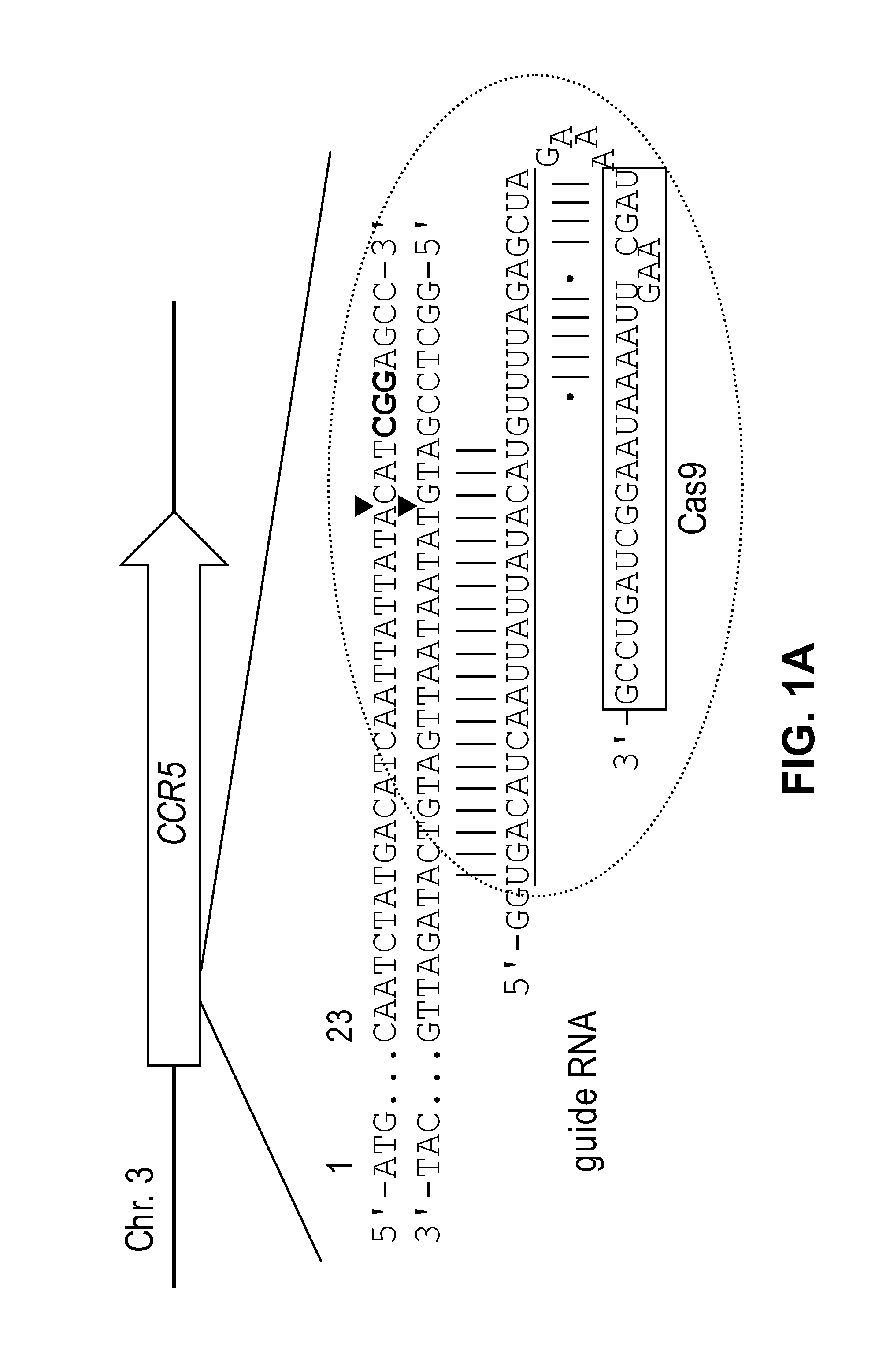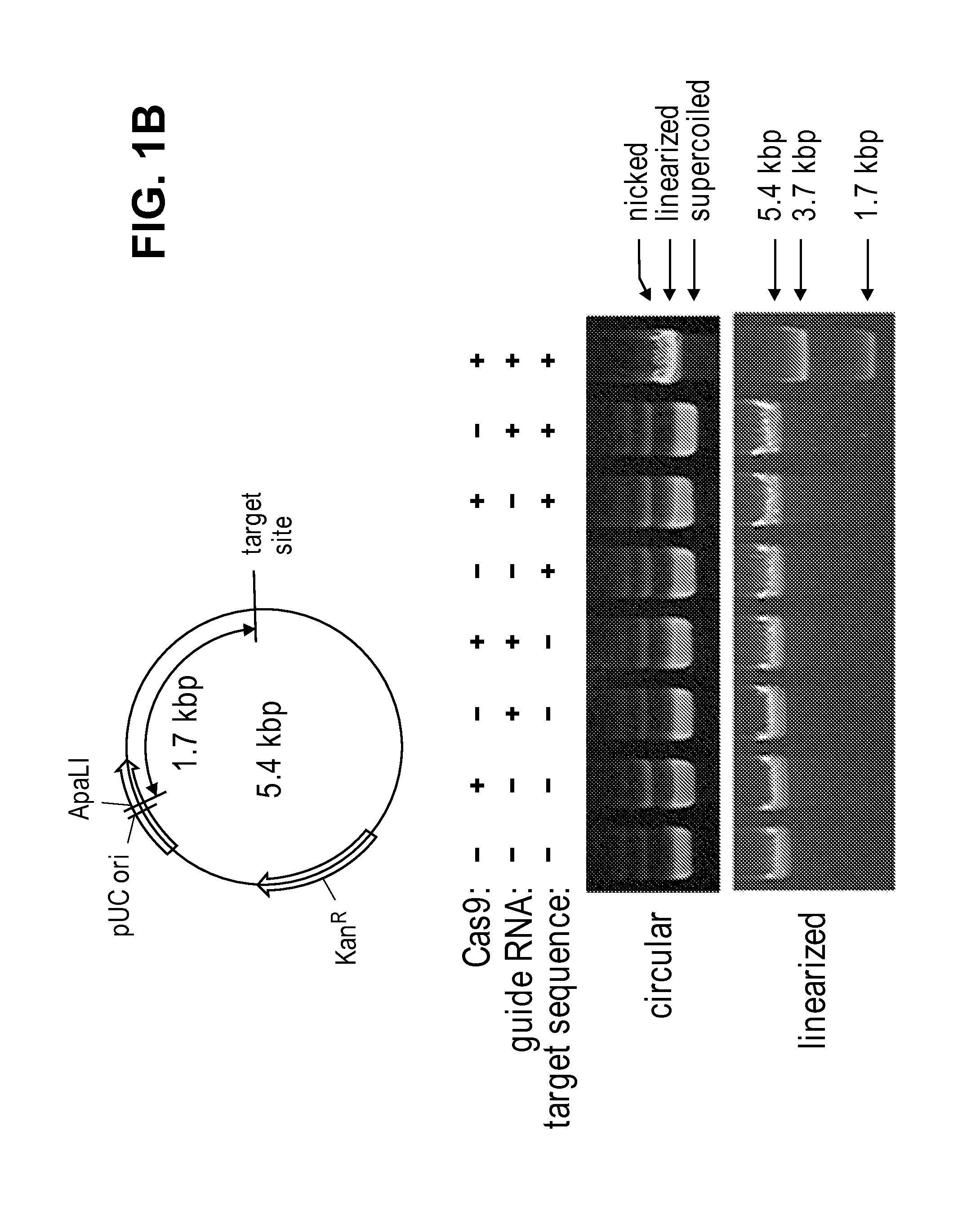Composition for cleaving a target DNA comprising a guide RNA specific for the target DNA and cas protein-encoding nucleic acid or cas protein, and use thereof
a technology of target dna and guide rna, which is applied in the direction of hydrolases, enzymes, biochemical apparatus and processes, etc., can solve the problems of inability to develop a genome editing method using the rna-guided endonuclease(rgen) based on the crispr/cas system, the rflp limit is limited, and the enzymes tend to underestimate the mutation frequency
- Summary
- Abstract
- Description
- Claims
- Application Information
AI Technical Summary
Benefits of technology
Problems solved by technology
Method used
Image
Examples
example 1
[0161]1-1. DNA Cleavage Activity of Cas9 Protein
[0162]Firstly, the DNA cleavage activity of Cas9 derived from Streptococcus pyogenes in the presence or absence of a chimeric guide RNA in vitro was tested.
[0163]To this end, recombinant Cas9 protein that was expressed in and purified from E. coli was used to cleave a predigested or circular plasmid DNA that contained the 23-base pair (bp) human CCR5 target sequence. A Cas9 target sequence consists of a 20-bp DNA sequence complementary to crRNA or a chimeric guide RNA and the trinucleotide (5′-NGG-3′) protospacer adjacent motif (PAM) recognized by Cas9 itself (FIG. 1A).
[0164]Specifically, the Cas9-coding sequence (4,104 bp), derived from Streptococcus pyogenes strain M1 GAS (NC—002737.1), was reconstituted using the human codon usage table and synthesized using oligonucleotides. First, 1-kb DNA segments were assembled using overlapping ˜35-mer oligonucleotides and Phusion polymerase (New England Biolabs) and cloned ...
example 2
Proteinaceous RGEN-Mediated Genome Editing
[0185]RGENs can be delivered into cells in many different forms. RGENs consist of Cas9 protein, crRNA, and tracrRNA. The two RNAs can be fused to form a single-chain guide RNA (sgRNA). A plasmid that encodes Cas9 under a promoter such as CMV or CAG can be transfected into cells. crRNA, tracrRNA, or sgRNA can also be expressed in cells using plasmids that encode these RNAs. Use of plasmids, however, often results in integration of the whole or part of the plasmids in the host genome. The bacterial sequences incorporated in plasmid DNA can cause unwanted immune response in vivo. Cells transfected with plasmid for cell therapy or animals and plants derived from DNA-transfected cells must go through a costly and lengthy regulation procedure before market approval in most developed countries. Furthermore, plasmid DNA can persist in cells for several days post-transfection, aggravating off-target effects of RGENs.
[0186]Here, we used recombinant Ca...
example 3
RNA-Guided Genome Editing in Mice
[0189]To examine the gene-targeting potential of RGENs in pronuclear (PN)-stage mouse embryos, the forkhead box N1 (Foxn1) gene, which is important for thymus development and keratinocyte differentiation (Nehls et al., 1996), and the protein kinase, DNA activated, catalytic polypeptide (Prkdc) gene, which encodes an enzyme critical for DNA DSB repair and recombination (Taccioli et al., 1998) were used.
[0190]To evaluate the genome-editing activity of the Foxn1-RGEN, we injected Cas9 mRNA (10-ng / μl solution) with various doses of the sgRNA (FIG. 5a) into the cytoplasm of PN-stage mouse embryos, and conducted T7 endonuclease I (T7E1) assays (Kim et al. 2009) using genomic DNAs obtained from in vitro cultivated embryos (FIG. 6a).
[0191]Alternatively, we directly injected the RGEN in the form of recombinant Cas9 protein (0.3 to 30 ng / μl) complexed with the two-fold molar excess of Foxn1-specific sgRNA (0.14 to 14 ng / μl) into the cytoplasm or pronucleus of ...
PUM
| Property | Measurement | Unit |
|---|---|---|
| pH | aaaaa | aaaaa |
| volume | aaaaa | aaaaa |
| pH | aaaaa | aaaaa |
Abstract
Description
Claims
Application Information
 Login to View More
Login to View More - R&D
- Intellectual Property
- Life Sciences
- Materials
- Tech Scout
- Unparalleled Data Quality
- Higher Quality Content
- 60% Fewer Hallucinations
Browse by: Latest US Patents, China's latest patents, Technical Efficacy Thesaurus, Application Domain, Technology Topic, Popular Technical Reports.
© 2025 PatSnap. All rights reserved.Legal|Privacy policy|Modern Slavery Act Transparency Statement|Sitemap|About US| Contact US: help@patsnap.com



